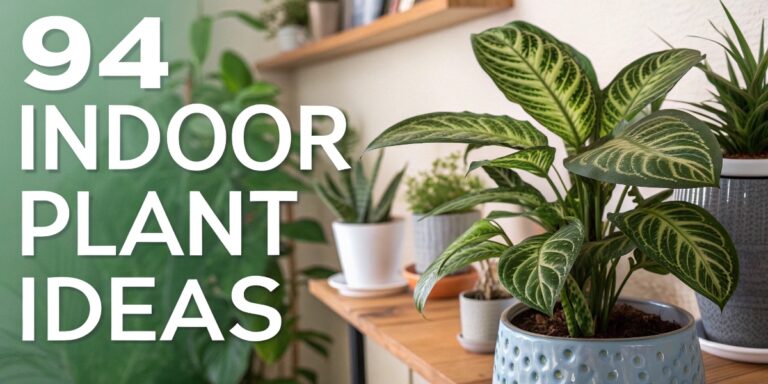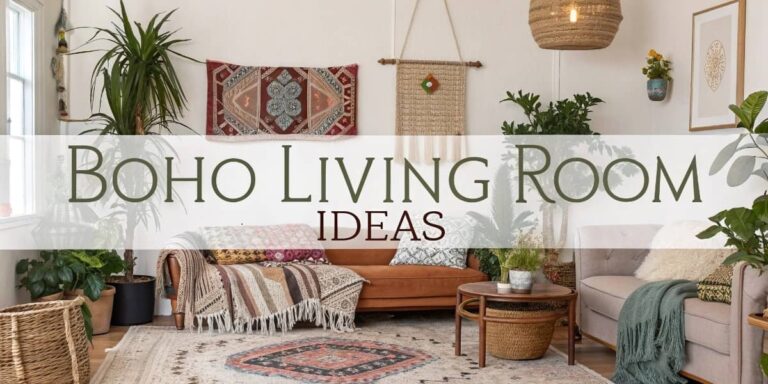Raised Garden Bed Ideas
There’s a unique satisfaction that comes from nurturing a vibrant garden, watching your plants flourish, and eventually harvesting fresh produce or admiring beautiful blooms right in your own backyard.
For many homeowners, however, traditional in-ground gardening can present a host of challenges: from stubborn weeds and poor soil quality to pesky critters and the physical strain of bending over.
But what if there was a simpler, more efficient way to cultivate your green thumb and transform your outdoor space into a thriving oasis?
Enter the raised garden bed.
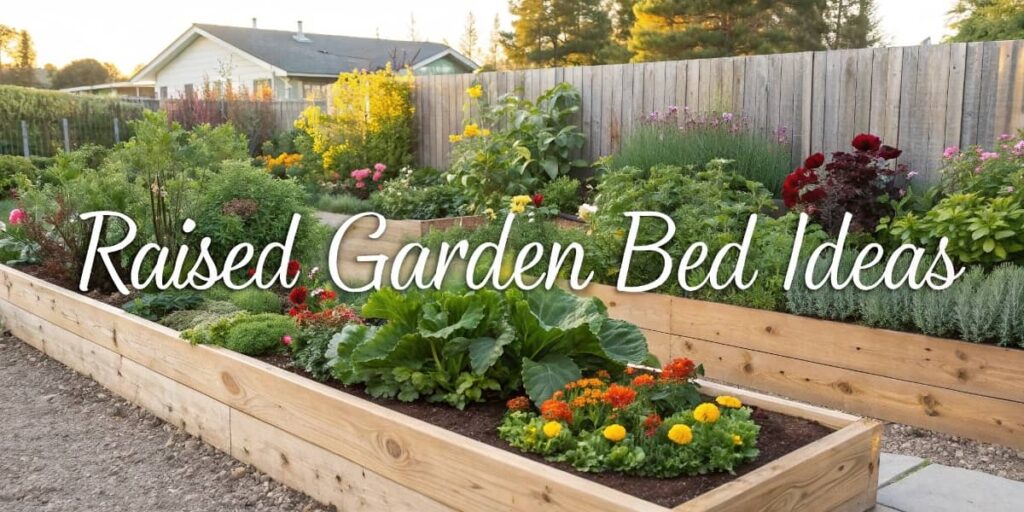
Raised garden beds have revolutionized home gardening, offering a practical and aesthetically pleasing solution for gardeners of all skill levels.
These elevated planting spaces provide unparalleled control over soil conditions, improve drainage, and significantly reduce the effort required for weeding and pest management.
Whether you’re a seasoned gardener looking to expand your growing capacity or a beginner eager to start your first successful patch, raised beds offer a versatile and rewarding experience.
They’re perfect for cultivating organic vegetables, fragrant herbs, or a stunning array of flowers, making gardening more accessible and enjoyable.
In this comprehensive guide, we’ll delve into 55 innovative and inspiring raised garden bed ideas designed specifically for homeowners. From budget-friendly DIY projects using repurposed materials to elegant, multi-tiered designs and space-saving vertical solutions, you’ll discover a wealth of creative approaches to enhance your landscape.
We’ll explore various materials like durable cedar, versatile metal, and eco-friendly recycled options, alongside practical tips for construction, soil preparation, and ongoing maintenance. Get ready to unlock the full potential of your garden and create a beautiful, productive outdoor sanctuary that reflects your personal style and passion for growing.
55 Raised Garden Bed Ideas
Now for the fun part! You’ve learned why raised beds are amazing and how to plan for them. It’s time to get inspired. Here are 55 creative and practical raised garden bed ideas. There’s something here for every homeowner, no matter your style, budget, or space. Let’s explore!
A. Classic & Simple DIY Ideas
These ideas are perfect if you love a traditional look or want to build something straightforward. They often use common materials and are great for beginners.
1. The Simple Cedar Box
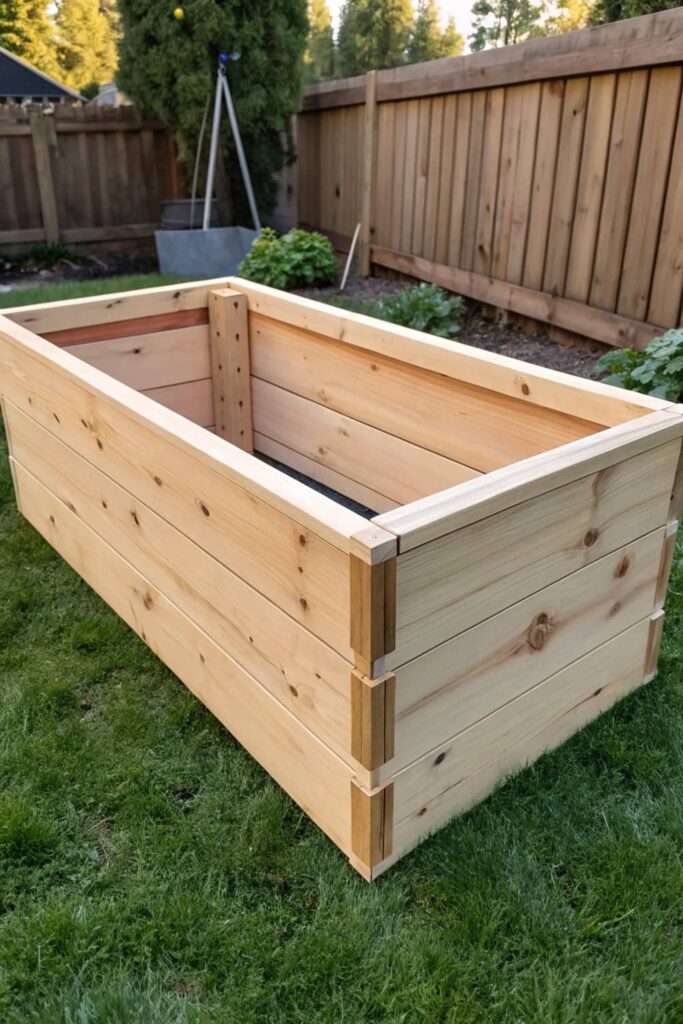
This is a timeless choice. Cedar is naturally resistant to rot and insects. It smells wonderful too! You can build a simple rectangular box using cedar planks. It’s sturdy, looks great, and will last for many years. Just cut your boards to size, screw them together at the corners, and you’ve got a beautiful raised bed. It’s a classic for a reason.
2. The Budget-Friendly Pine Bed
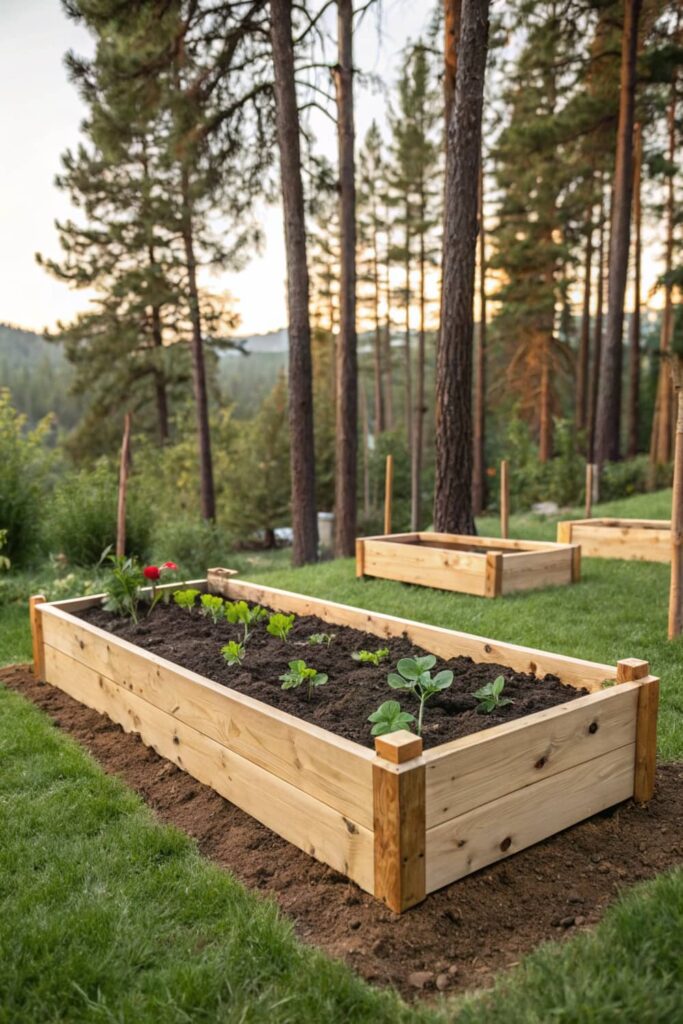
If you’re watching your pennies, pine is a fantastic option. It’s much more affordable than cedar. While it might not last as long as cedar, you can extend its life. Consider lining the inside with pond liner or heavy-duty plastic. This protects the wood from constant moisture. Pine is easy to work with, making it a great choice for your first DIY project. You can always replace it later if you fall in love with raised bed gardening!
3. The Long-Lasting Redwood Planter
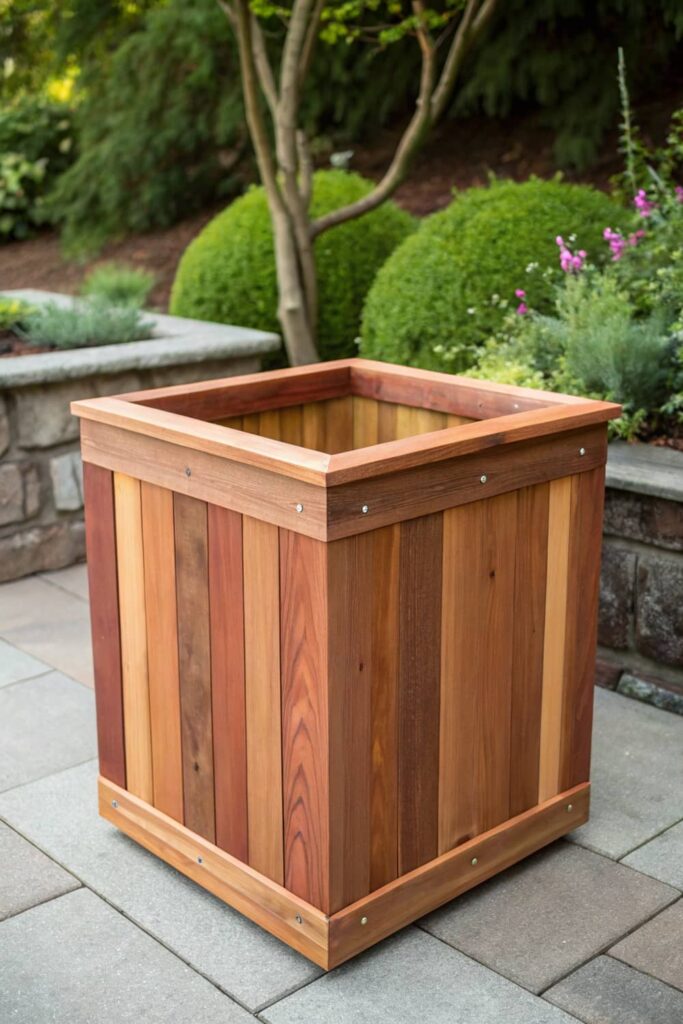
Redwood is another excellent choice for durability. Like cedar, it naturally resists rot and pests. It has a beautiful reddish hue that adds warmth to any garden. Redwood can be a bit pricier, but it’s an investment that pays off. Your redwood raised bed will stand strong for decades. It’s perfect if you want a permanent, low-maintenance structure.
4. The Rustic Douglas Fir Garden
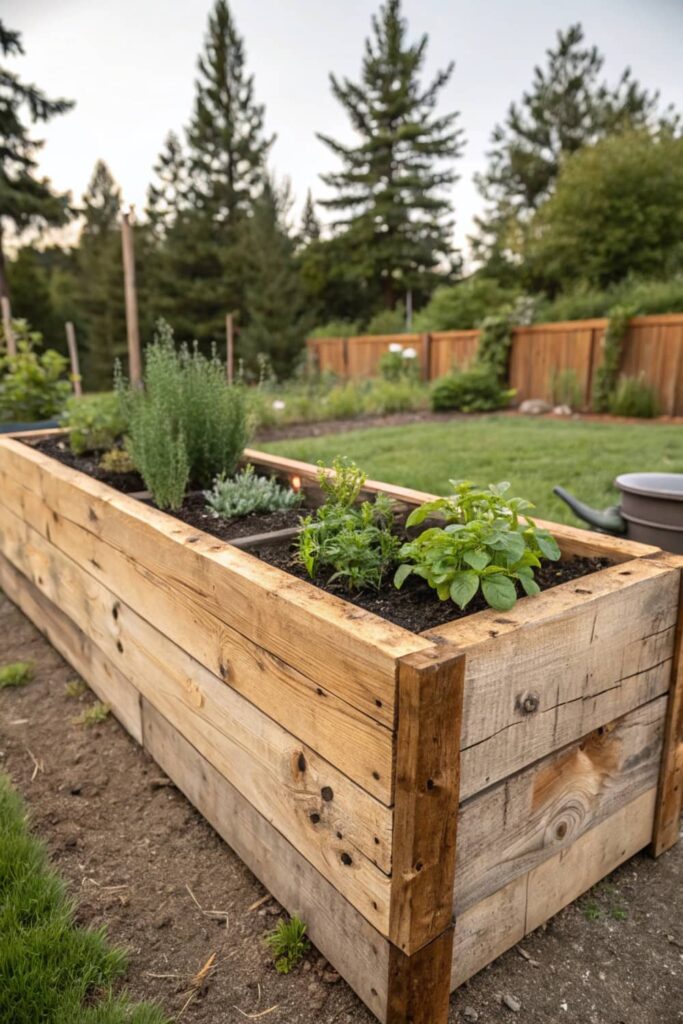
Douglas fir is a strong and relatively inexpensive wood. It’s a good middle-ground option between pine and cedar. It has a lovely grain and can give your garden a rustic, natural feel. Make sure to choose untreated lumber. You can also apply a food-safe sealant to the outside for extra protection. This wood is widely available and easy to find at most lumber yards.
5. The Elegant Cypress Garden Bed
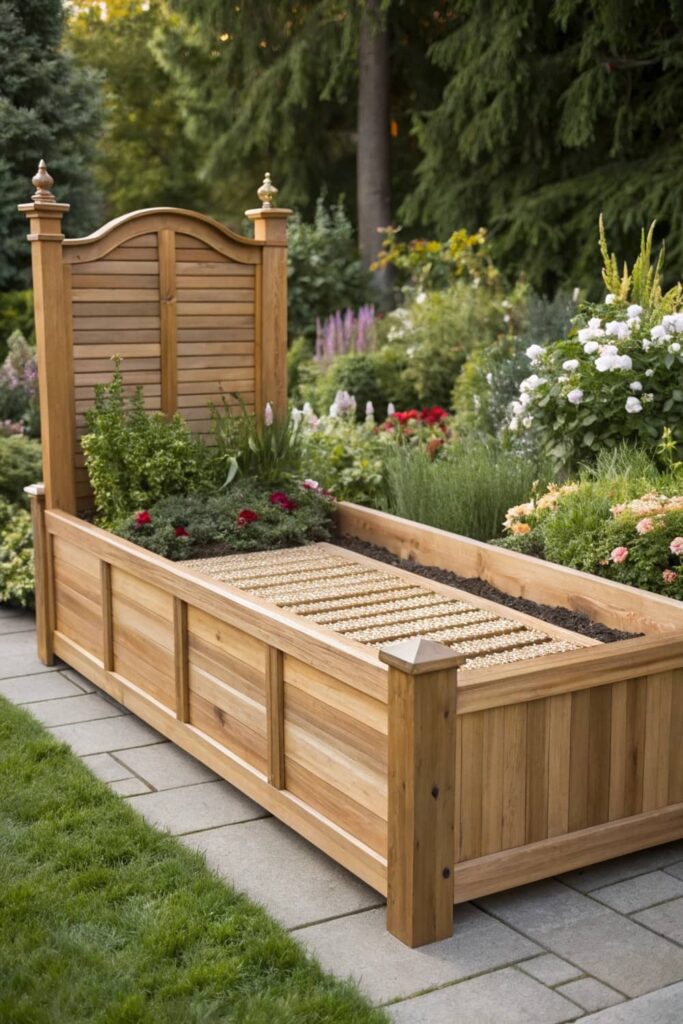
Cypress wood is known for its resistance to decay and insects. It’s a lightweight wood, making it easier to work with. Cypress has a beautiful, light color that can brighten up your garden space. It’s a durable option that will hold up well against the elements. If you want a raised bed that’s both practical and pretty, cypress is a great contender.
B. Upcycled & Repurposed Ideas
These ideas are all about giving new life to old items. They’re often very budget-friendly and add a unique, personal touch to your garden. Plus, it’s great for the environment!
6. Cinder Block Garden
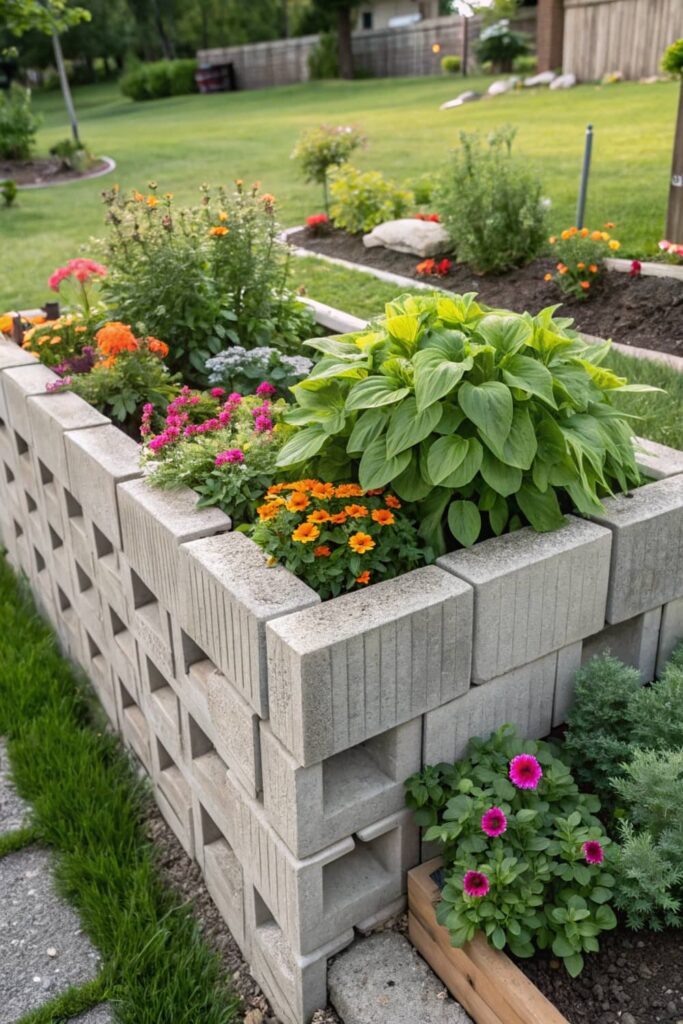
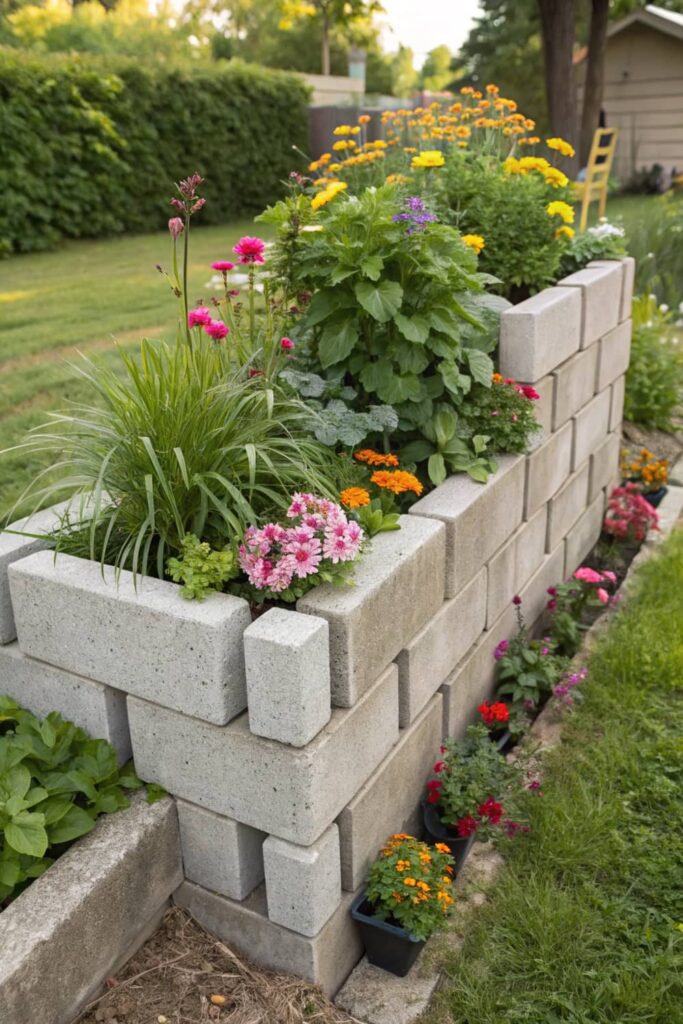
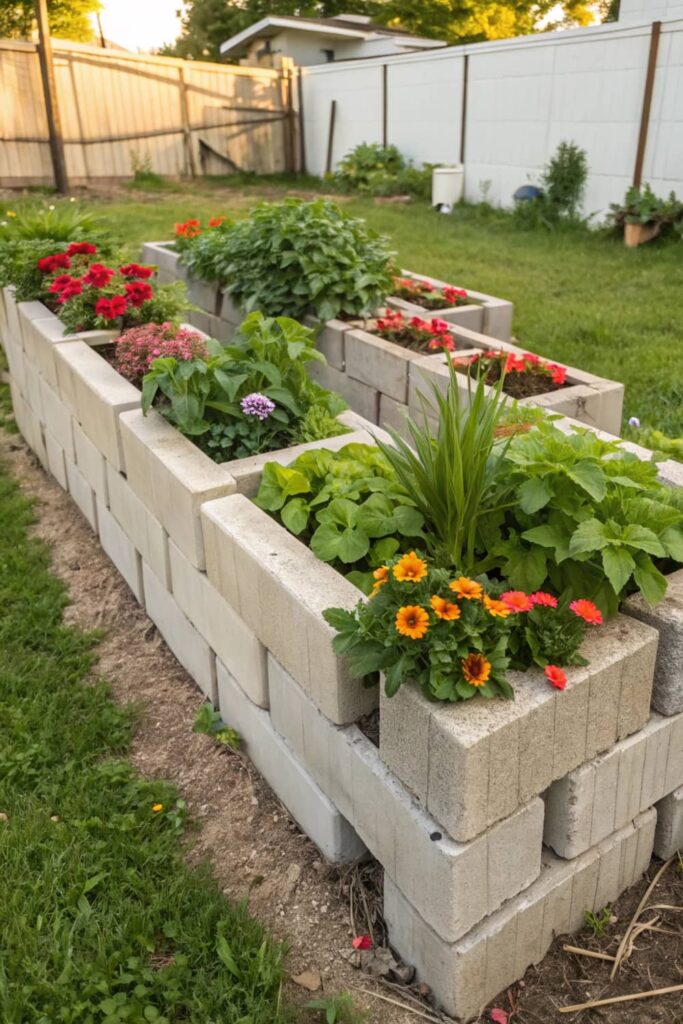
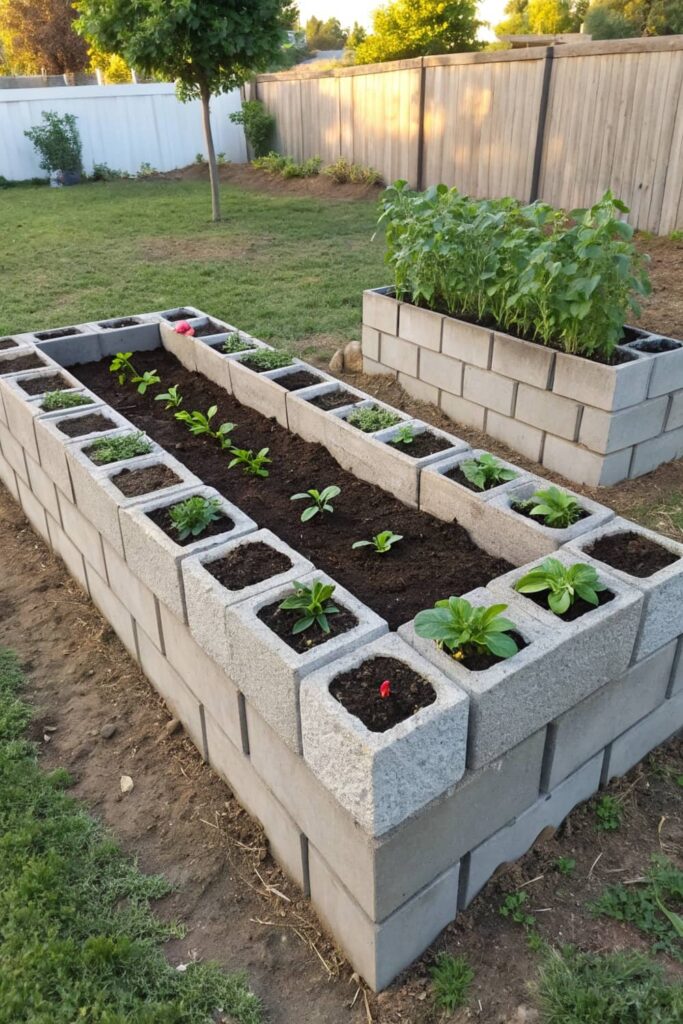
Cinder blocks are incredibly versatile and cheap. You can stack them to create raised beds of any height or shape. They’re super easy to assemble – no tools needed! Just lay them out, stack them up, and fill them with soil. You can even plant herbs or small flowers in the holes of the blocks. A word of caution: some cinder blocks can leach lime, which might affect soil pH. You can line the inside with plastic sheeting to prevent this. They offer a modern, industrial look.
7. Wine Box Herb Garden

Got some old wooden wine boxes? They make charming, small raised beds, perfect for herbs or a few flowers. They add a rustic, European flair to your patio or balcony. Just make sure they have drainage holes at the bottom. You can line them with landscape fabric to keep the soil in. These are fantastic for small spaces or for creating a collection of mini-gardens.
8. Galvanized Water Trough Planter
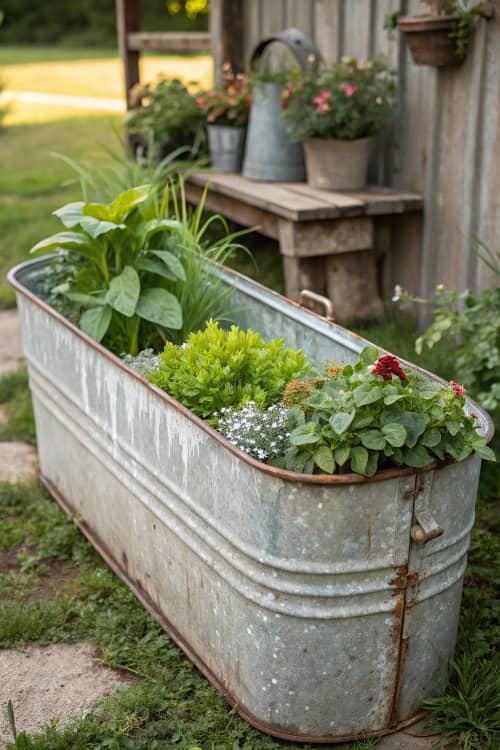
Metal water troughs, often used for livestock, are fantastic for raised beds. They’re durable, deep, and have a cool, industrial farm look. They come in various sizes, so you can find one that fits your space. Make sure to drill drainage holes in the bottom if they don’t already have them. These troughs are long-lasting and make a bold statement in any garden.
9. Repurposed Pallet Garden
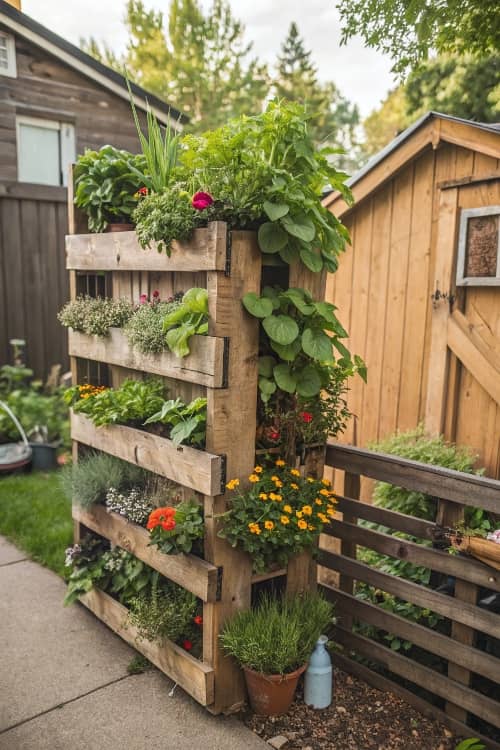
Wooden pallets can be transformed into surprisingly functional raised beds. You can often find them for free or very cheap. You’ll need to disassemble them and use the wood to build your bed. Be sure to use heat-treated (HT) pallets, not chemically treated (MB) ones, especially for food. Pallets give a very rustic, DIY vibe to your garden. They’re a great way to recycle and create something useful.
10. Old Tire Flower Bed
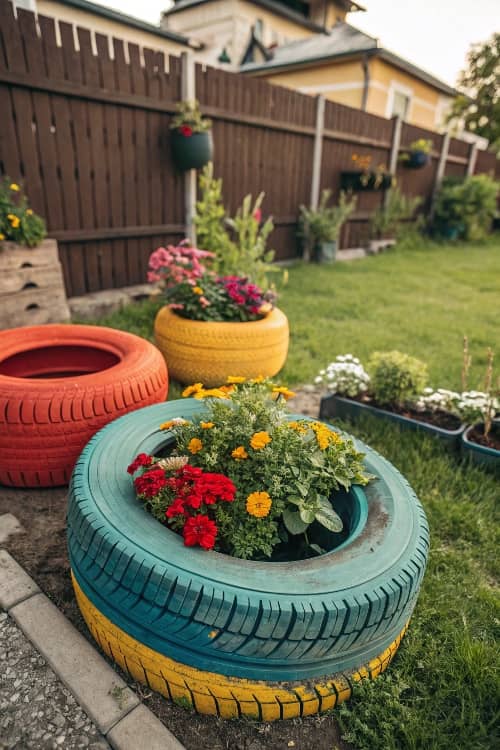
While not ideal for growing food due to potential chemical leaching, old tires can be a fun, quirky option for a flower bed. You can stack them to create height and even paint them vibrant colors. They retain heat well, which can be good for some plants. This is a very budget-friendly and creative way to repurpose something that would otherwise go to a landfill. Just ensure good drainage.
C. Space-Saving & Small Garden Ideas
Living in a smaller home or apartment? No problem! These raised bed ideas are designed to maximize your growing space, even if you don’t have a big yard.
11. Vertical Tiered Garden
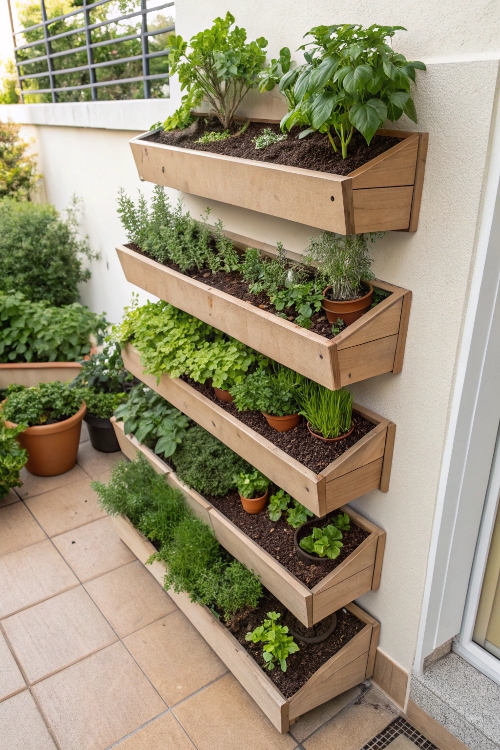
Go up, not out! A vertical tiered garden uses multiple levels of planters. They stack on top of each other or are arranged vertically. This is perfect for growing lots of herbs, strawberries, or leafy greens in a tiny footprint. You can buy ready-made vertical planters or build your own with stacked wooden boxes. They’re a real space-saver and look impressive.
12. Raised Bed on Wheels
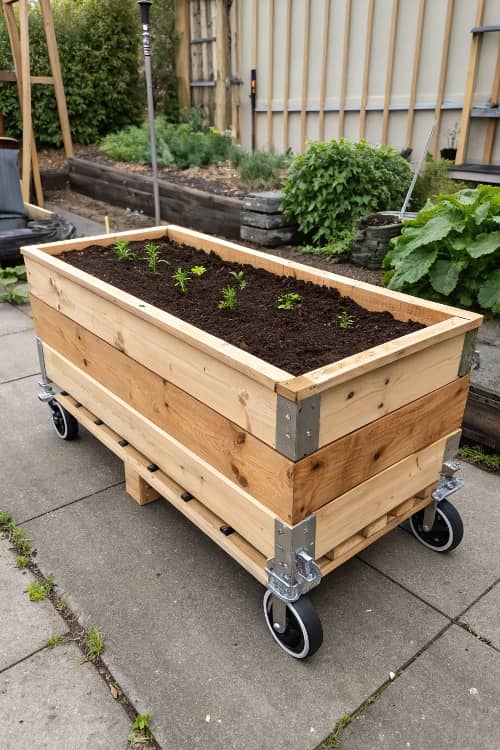
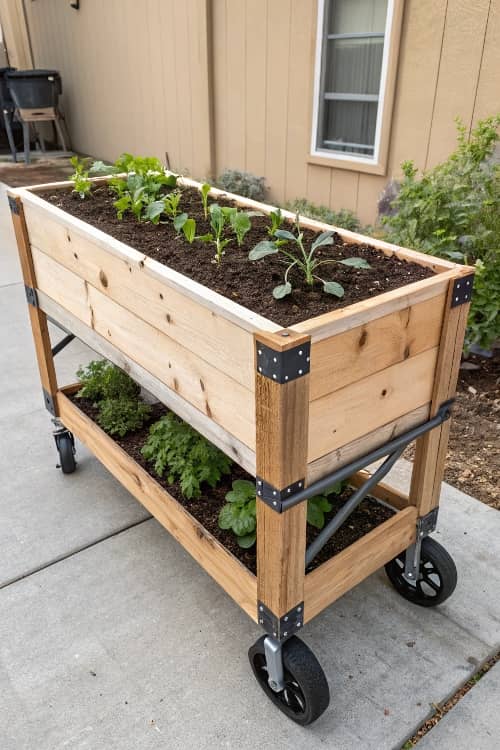
Need flexibility? A raised bed with wheels is your answer. You can move it around to follow the sun, protect plants from bad weather, or simply rearrange your patio. Look for sturdy casters that can handle the weight of soil and plants. This is fantastic for balconies, small patios, or even indoors if you have enough light. Mobility makes gardening so much easier.
13. Wall-Mounted Hanging Planters
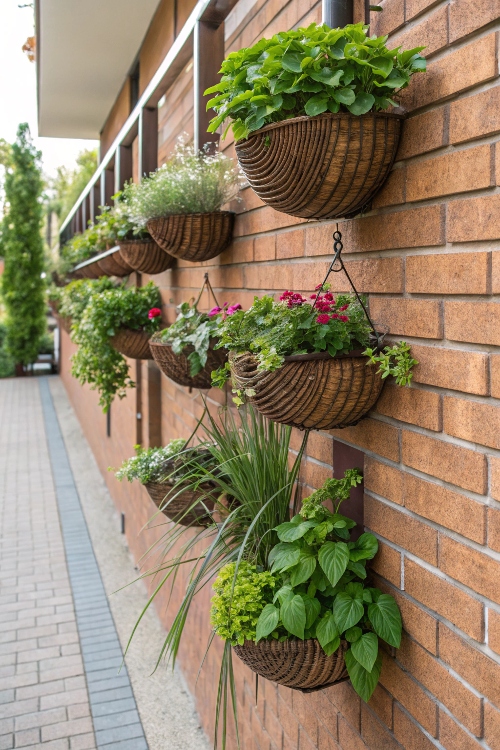
Turn a blank wall into a living green space! Wall-mounted planters are perfect for herbs, succulents, or cascading flowers. You can use old pallets, wooden boards with attached pots, or fabric pockets. They add beauty and greenery without taking up any floor space. Just make sure your wall can support the weight and that the plants get enough light.
14. Corner Raised Garden Bed
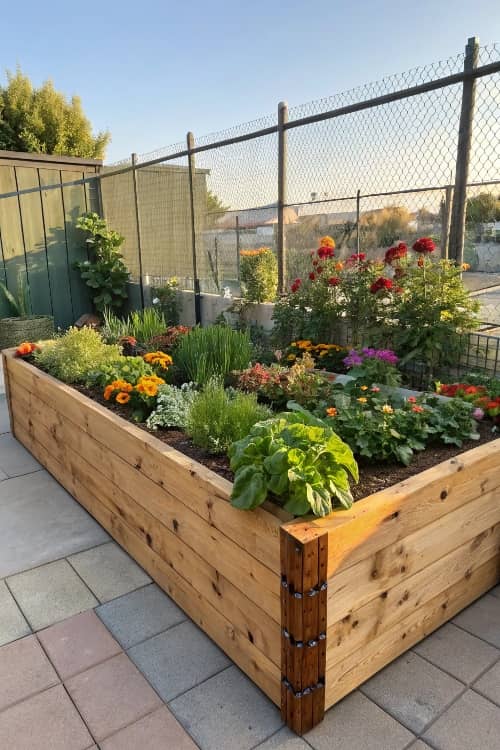
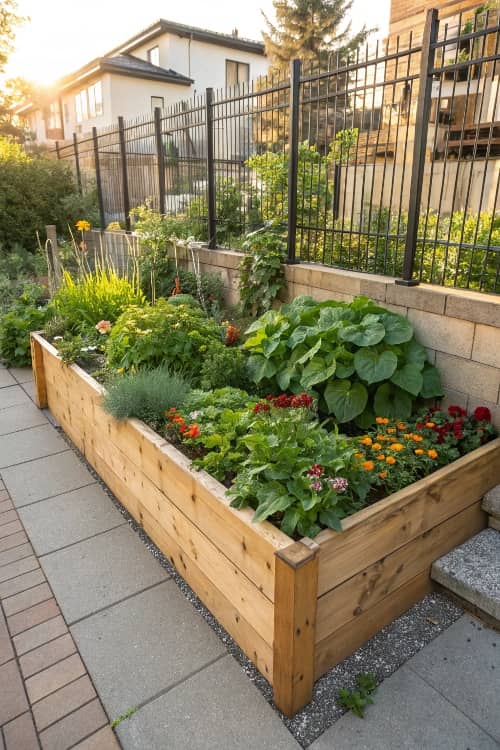
Don’t let those awkward corner spaces go to waste. A corner-shaped raised bed fits perfectly into an unused nook. You can design it as an L-shape or a custom curve. This maximizes planting area in a spot that might otherwise be ignored. It’s a smart way to utilize every inch of your outdoor space and create a cozy garden retreat.
15. Elevated Table Garden
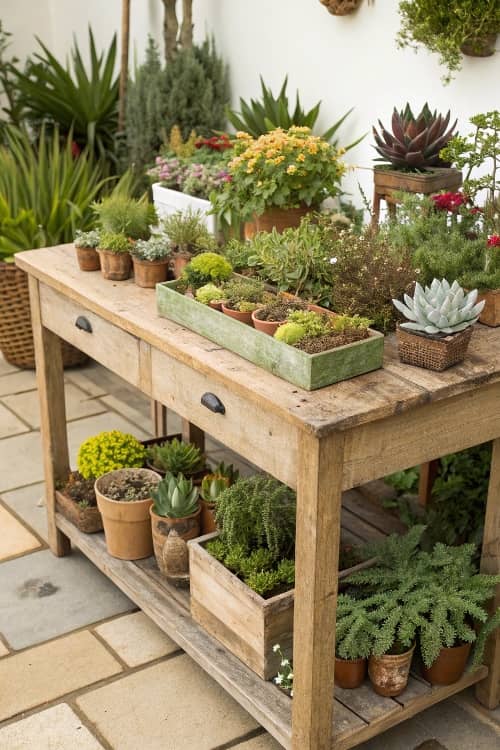
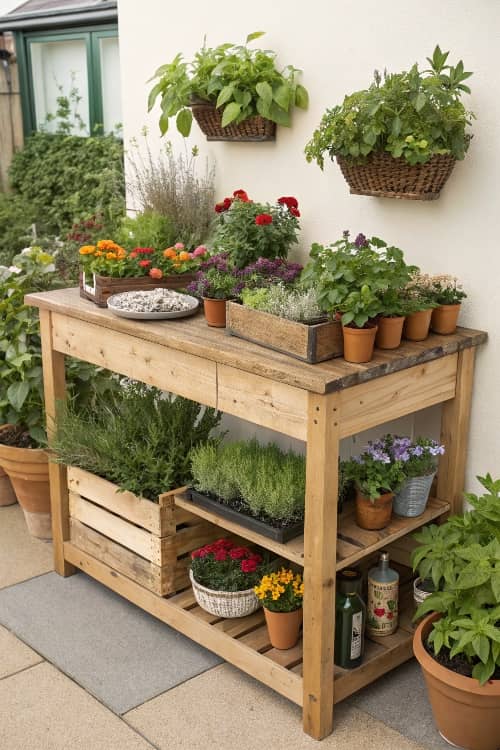
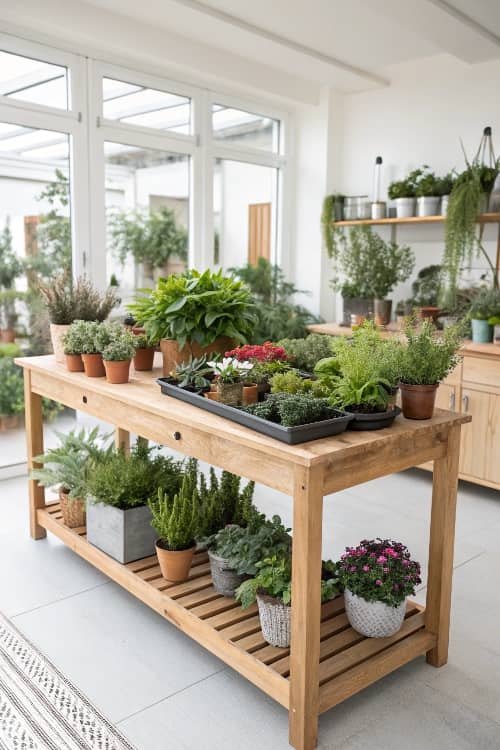
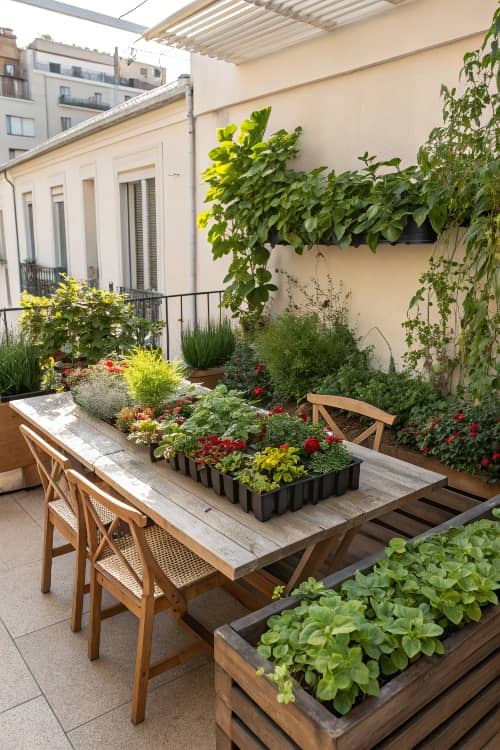

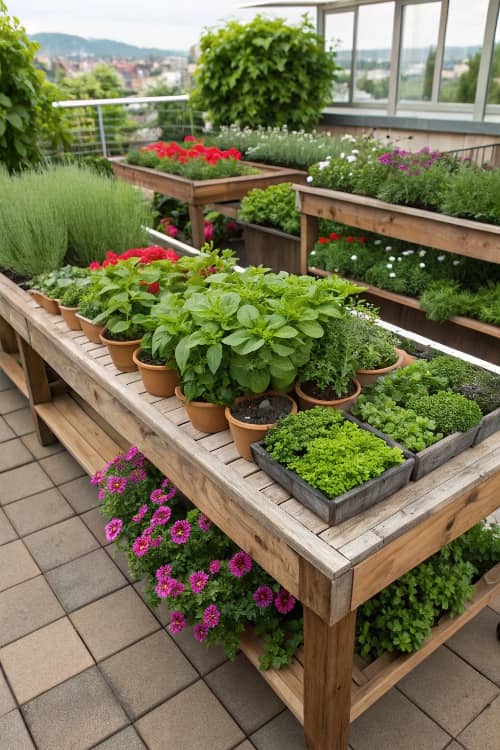
This is a fantastic option for patios, decks, or anyone who prefers to garden standing up. An elevated table garden is essentially a raised bed on legs. It brings the planting area up to waist height. This makes planting, weeding, and harvesting incredibly comfortable. Many come with a shelf underneath for storing tools. It’s a neat and tidy way to garden in a small area.
D. Creative & Unique Designs
Want your garden to stand out? These ideas go beyond the basic box. They add personality and flair to your outdoor space.
16. U-Shaped Garden Bed
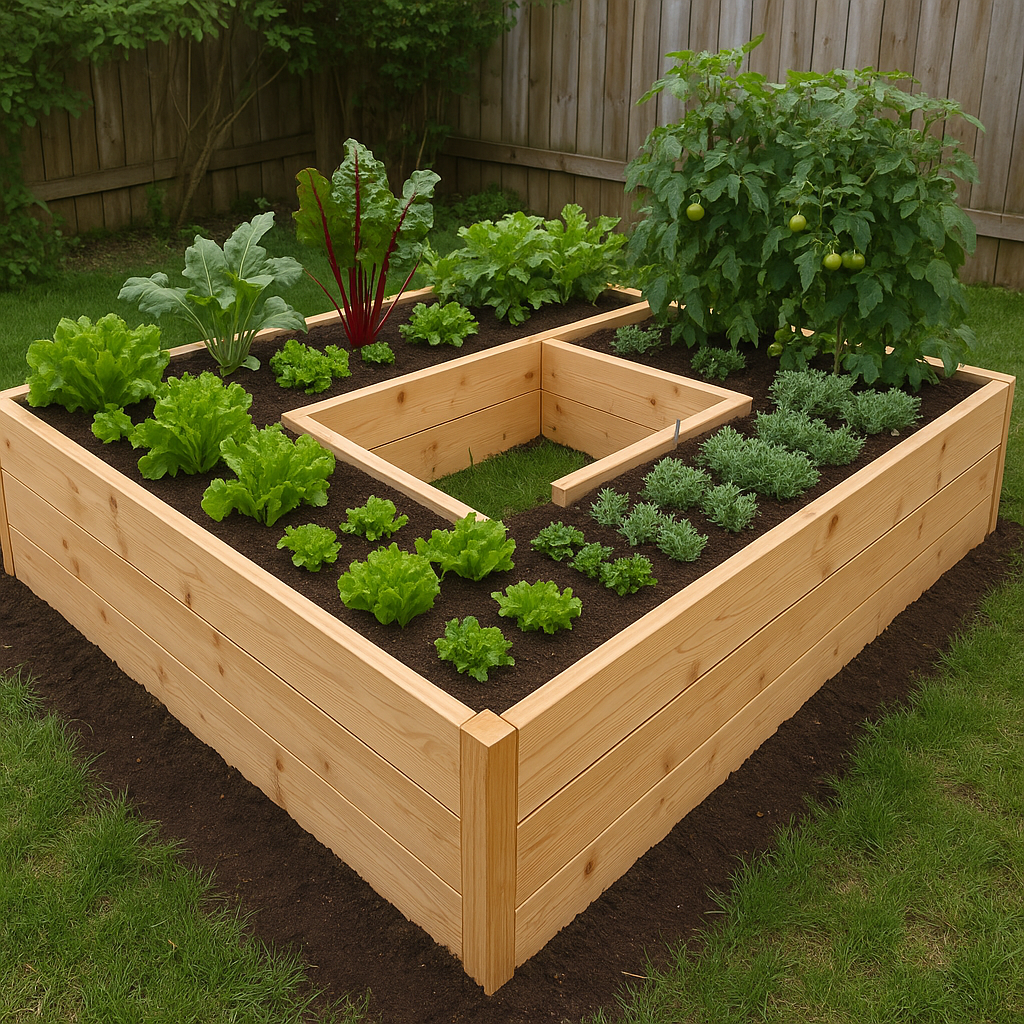
A U-shaped raised bed is super efficient. It allows you to stand in the middle and reach plants on three sides. This maximizes your planting area while keeping everything within easy reach. It’s a great design for larger gardens where you want to grow a lot of different crops. It feels like you’re surrounded by your garden!
17. L-Shaped Garden Bed
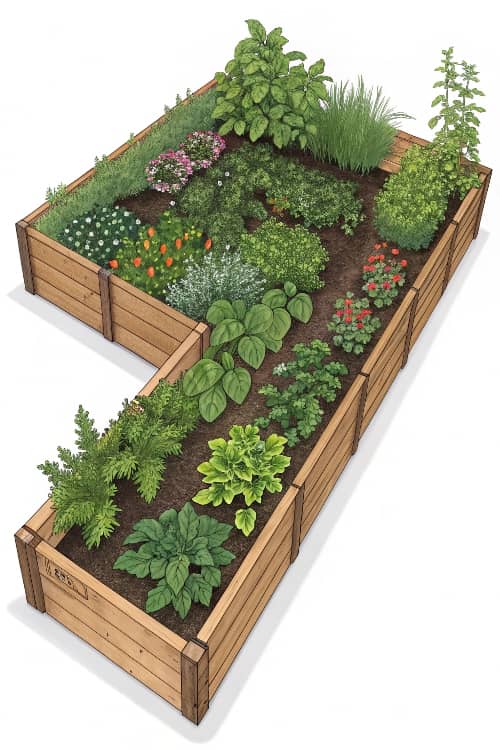
Similar to the U-shape, an L-shaped raised bed is perfect for fitting into corners or along fences. It provides ample growing space and allows for easy access. You can use the L-shape to define different garden zones or create a cozy seating area within the
L-shape. It’s a versatile design that looks great in many settings.
18. Circular Raised Bed
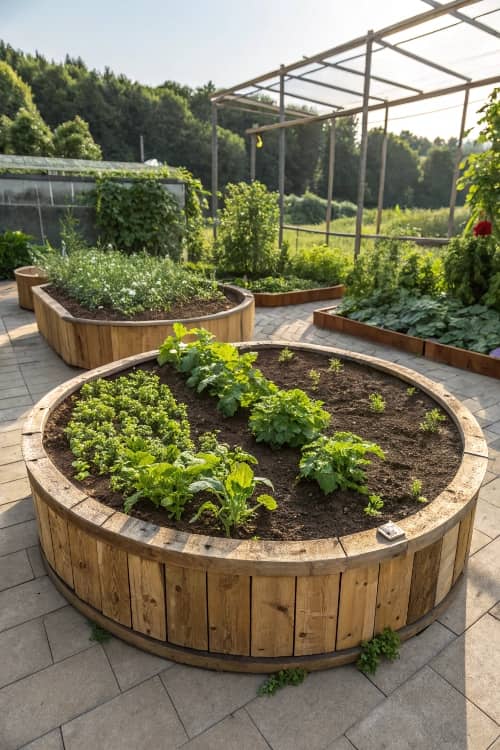
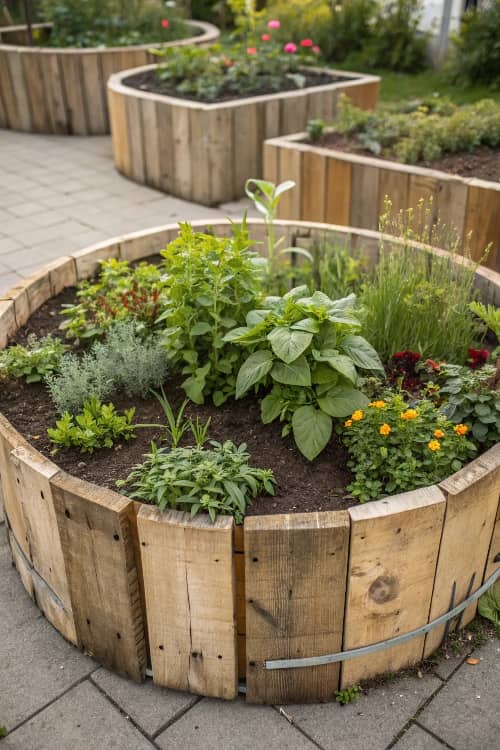
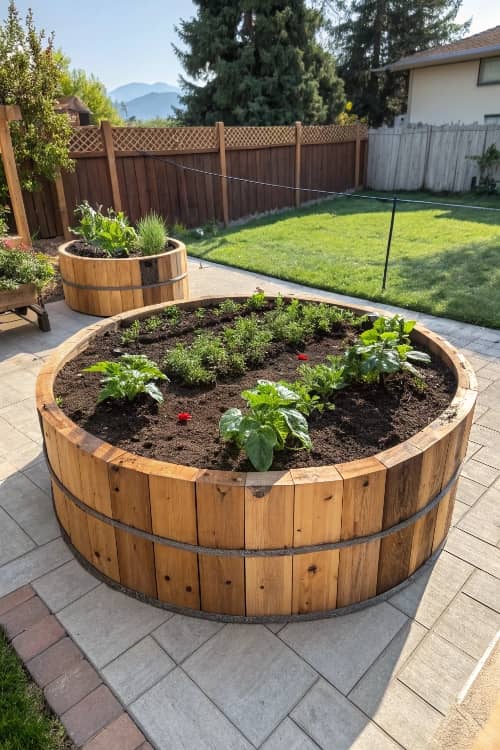
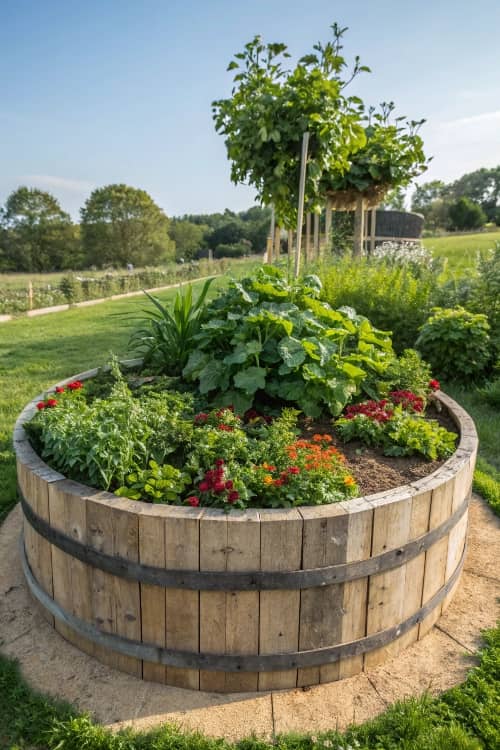
Break away from straight lines! A circular raised bed adds a soft, organic feel to your garden. They can be made from stone, brick, or even flexible metal sheeting. Planting in a circle can be fun and visually appealing. It creates a natural focal point in your yard. Plus, it’s easy to reach all your plants from the edges.
19. Star-Shaped Garden Bed
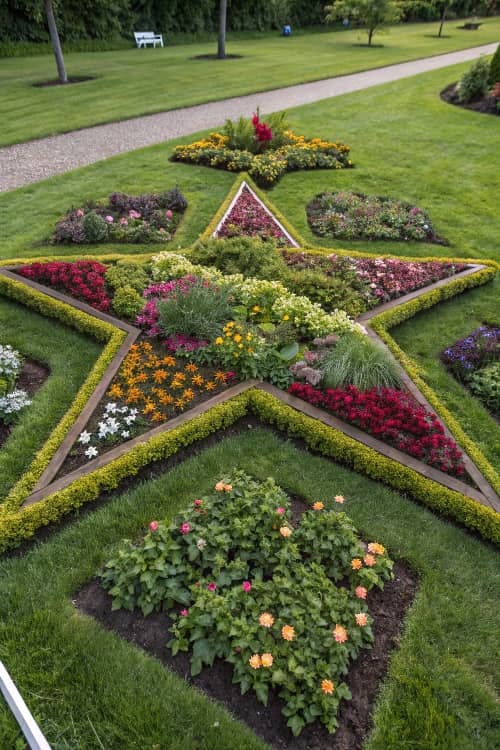
Want something truly unique? A star-shaped raised bed is a real showstopper. This design works well for herbs or flowers, where each point of the star can hold a different variety. It takes a bit more effort to build, but the visual impact is worth it. Imagine the delight of your neighbors seeing this creative garden feature!
20. Gabion Wall Raised Bed
Gabion walls are wire cages filled with rocks. They create a very modern, industrial, and sturdy raised bed. They offer excellent drainage and can be a striking design element. You can fill the cages with local stones for a natural look or use decorative rocks for a more polished finish. This is a durable and long-lasting option that adds architectural interest.
E. Advanced & Feature-Rich Ideas
These ideas incorporate extra features for convenience, extended growing, or specialized gardening techniques. They might require a bit more planning or skill, but the benefits are huge.
21. Raised Bed with Built-in Trellis
Perfect for climbing plants like tomatoes, cucumbers, or beans. A built-in trellis provides instant support for your vining crops. It saves space and keeps your plants healthy by lifting them off the ground. You can integrate a simple wire mesh, a wooden lattice, or even rebar for a modern look. It’s a smart way to maximize your harvest.
22. Raised Bed with Greenhouse Cover
Extend your growing season! Adding a removable greenhouse cover to your raised bed creates a mini-climate. This protects plants from cold snaps, strong winds, and pests. It allows you to start seeds earlier in spring and keep harvesting later into fall. You can use clear plastic sheeting over a simple frame. It’s like having a tiny greenhouse right in your garden.
23. Self-Watering Raised Bed
Busy gardener? A self-watering raised bed is a dream come true. These beds have a built-in water reservoir at the bottom. The plants draw water up as they need it, reducing how often you need to water. This saves time and ensures your plants get consistent moisture. It’s a fantastic solution for hot climates or for when you’re away on vacation.
24. Hugelkultur Raised Bed
Hugelkultur is a German term meaning
‘hill culture.’ This method involves filling the bottom of your raised bed with logs, branches, and other organic matter. These materials slowly decompose, releasing nutrients and holding moisture. It’s a fantastic way to improve soil fertility and water retention over time. It’s a very sustainable and low-maintenance approach once established.
25. Raised Bed with Integrated Seating
Combine gardening with relaxation! A raised bed with a wide edge or a built-in bench offers a comfortable spot to sit. You can weed, plant, or just enjoy your garden from a cozy perch. It’s a great way to make your garden a more inviting and functional space. It’s perfect for taking a break and admiring your hard work.
F. Modern & Minimalist Ideas
If you love clean lines and a sleek look, these ideas are for you. They focus on simplicity and contemporary design.
26. Sleek Metal Raised Bed
Think galvanized steel or powder-coated aluminum. These materials offer a very modern and industrial aesthetic. They are durable, long-lasting, and require minimal maintenance. Metal beds can be a striking contrast to lush greenery. They fit perfectly into contemporary home designs.
27. Concrete Block Raised Bed
Beyond basic cinder blocks, smooth concrete blocks can create a very clean and minimalist look. They are sturdy and can be arranged in various patterns. You can paint them to match your home or leave them natural for a raw, modern feel. They offer a strong, permanent structure for your garden.
28. Corten Steel Planter
Corten steel develops a beautiful, rust-like patina over time. This creates a warm, earthy, and very modern look. It’s incredibly durable and will last for decades. Corten steel planters are a popular choice for high-end landscape designs. They add a touch of artistic flair to your outdoor space.
29. Simple Geometric Design
Focus on basic shapes like squares, rectangles, or triangles. Arrange multiple beds in a grid or a repeating pattern. This creates a very organized and visually appealing garden. It’s a minimalist approach that emphasizes structure and order. It’s perfect for a tidy and modern aesthetic.
30. White-Washed Wood Raised Bed
Paint your wooden raised bed a crisp white. This creates a bright, fresh, and modern look. It contrasts beautifully with green foliage and colorful flowers. White-washed beds can make a small space feel larger and more open. It’s a simple way to update a classic wooden bed.
G. Country & Cottage Style Ideas
For a charming, whimsical, and slightly informal garden, these ideas will fit right in. They evoke a sense of tradition and comfort.
31. Rough-Sawn Timber Bed
Use unplaned, rough-sawn timber for a truly rustic feel. The natural texture of the wood adds character and charm. It looks like it’s been there for ages, blending seamlessly into a country landscape. This is a simple yet effective way to create a natural, earthy garden bed.
32. Stone Wall Raised Bed
Build your raised bed with natural stones. This creates a beautiful, timeless, and very durable structure. It can be dry-stacked or mortared for extra stability. Stone walls add a classic, old-world charm to your garden. They blend perfectly with natural surroundings and cottage gardens.
33. Wattle Raised Bed
Wattle fencing is made by weaving flexible branches (like willow or hazel) between upright stakes. You can use this technique to create a charming, rustic raised bed. It’s an eco-friendly and traditional method. Wattle beds have a unique, handcrafted look that’s perfect for a cottage garden.
34. Brick Raised Bed
Bricks offer a classic, sturdy, and elegant option. You can lay them in various patterns to create different looks. Brick raised beds are very durable and add a formal touch to your garden. They are perfect for defining garden spaces and creating a neat, traditional appearance.
35. Reclaimed Wood Raised Bed
Give old wood a new purpose! Use reclaimed barn wood, fence posts, or even old railway sleepers. This adds instant character and history to your garden. Each piece tells a story. Just be mindful of any chemical treatments on the wood, especially for food gardens. It’s a sustainable and charming choice.
H. Themed & Specialized Ideas
These ideas cater to specific gardening needs or add a fun, thematic element to your outdoor space.
36. Herb Spiral Raised Bed
An herb spiral is a compact, three-dimensional raised bed. It uses a spiral shape to create different microclimates. This allows you to grow herbs with varying needs (like sun-loving rosemary and moisture-loving mint) all in one small area. It’s a clever and attractive way to grow a diverse herb collection.
37. Keyhole Garden
A keyhole garden is a circular raised bed with a cut-out section, like a keyhole. This cut-out leads to a central compost basket. You add kitchen scraps and garden waste to the basket, which feeds nutrients directly to your plants. It’s super efficient for composting and watering. It’s a sustainable and productive design.
38. Salad Table
This is a shallow, elevated raised bed, often on legs, specifically designed for growing leafy greens. It’s perfect for a quick harvest of lettuce, spinach, and other salad ingredients. Being elevated, it keeps pests away and makes harvesting easy. It’s ideal for small spaces like patios or balconies.
39. Strawberry Tower
A strawberry tower is a vertical planter with pockets or openings for plants. It’s designed to grow many strawberry plants in a small footprint. The berries hang down, staying clean and easy to pick. It’s a sweet solution for maximizing your strawberry harvest.
40. Sensory Garden Bed
Design a raised bed with plants chosen for their scent, texture, and sound. Think fragrant herbs, soft lamb’s ear, or grasses that rustle in the wind. This creates an immersive and calming garden experience. It’s wonderful for engaging all your senses.
I. Integrated & Landscape Ideas
These ideas blend your raised beds seamlessly into your overall landscape design, creating cohesive and beautiful outdoor spaces.
41. Raised Bed as a Border
Use a long, narrow raised bed to define a pathway or border a patio. This creates a clean, structured edge to your landscape. It’s a great way to add plants and color while also providing a clear separation between areas. It adds a polished look to your garden.
42. Multi-Level Terraced Beds
If you have a sloped yard, terraced raised beds are a fantastic solution. Build multiple beds at different heights, stepping down the slope. This prevents erosion and creates beautiful, usable planting areas. It transforms an unusable slope into a productive and attractive garden feature.
43. Raised Bed Around a Tree
Create a circular raised bed around the base of a tree. This adds visual interest and provides a planting area for shade-loving plants. Just be careful not to pile soil too high against the tree trunk, as it can harm the tree. It’s a lovely way to integrate existing trees into your garden design.
44. Raised Bed with Built-in Pond/Water Feature
Combine the beauty of plants with the tranquility of water. Integrate a small pond or a bubbling water feature into one section of your raised bed. This adds a calming element and attracts wildlife. It’s a more advanced project but creates a truly unique and serene garden space.
45. Raised Bed as a Privacy Screen
Plant tall, dense plants in a raised bed to create a living privacy screen. Think bamboo (in a contained bed!), tall grasses, or climbing vines on a trellis. This is a beautiful and natural way to block unwanted views or create a secluded outdoor room. It adds greenery and seclusion.
J. Innovative & Future-Forward Ideas
These ideas push the boundaries of traditional raised beds, incorporating technology or unique concepts for the modern gardener.
46. Smart Raised Bed with Sensors
Embrace technology! A smart raised bed includes sensors that monitor soil moisture, temperature, and nutrient levels. It can even connect to an app on your phone. This helps you know exactly when to water or fertilize, taking the guesswork out of gardening. It’s gardening made easy and efficient.
47. LED Grow Light Integrated Bed
For indoor or low-light areas, integrate LED grow lights into your raised bed setup. This provides optimal light for plant growth, even in challenging conditions. It’s perfect for growing herbs or vegetables year-round, regardless of natural light. It brings the garden indoors.
48. Modular Raised Bed System
Modular systems use interlocking pieces that allow you to easily expand or reconfigure your raised beds. You can start small and add more sections as your garden grows. This offers incredible flexibility and adaptability. It’s a versatile solution for evolving gardening needs.
49. Transparent Side Raised Bed
Imagine seeing the roots grow! A raised bed with one transparent side (made of clear acrylic or polycarbonate) allows you to observe root development. This is fascinating for educational purposes or just for curiosity. It offers a unique window into the hidden world beneath the soil.
50. Edible Wall Raised Bed
Similar to wall-mounted planters, but on a larger scale. An edible wall uses a series of connected raised pockets or shelves to grow a vertical garden of edibles. It’s a stunning and productive way to utilize vertical space. It’s perfect for urban environments or small yards.
51. Rainwater Harvesting Integrated Bed
Design your raised bed to collect rainwater. This could involve a small gutter system that directs water from a nearby roof into the bed, or a built-in reservoir. It’s an eco-friendly way to water your plants and conserve resources. It makes your garden more self-sufficient.
52. Raised Bed with Cold Frame Attachment
A cold frame is a bottomless box with a transparent lid. Attaching one to your raised bed creates a protected environment for plants. It’s great for hardening off seedlings or extending the growing season into colder months. It’s a simple addition that offers big benefits.
53. Accessible Raised Bed for Wheelchairs
Design a raised bed with enough clearance underneath for a wheelchair to roll under. This allows gardeners with mobility challenges to comfortably access the planting area. It’s an inclusive design that makes gardening enjoyable for everyone. It promotes accessibility in the garden.
54. Raised Bed with Integrated Composter
Similar to the keyhole garden, but with a more defined composting section. This allows you to easily add kitchen scraps and garden waste directly into the bed. The decomposing material enriches the soil over time. It’s a convenient way to recycle organic matter and feed your plants.
55. Portable Mini Raised Beds
Small, lightweight raised beds that can be easily moved. These are perfect for apartment dwellers or those who want to experiment with different planting locations. They offer maximum flexibility and are great for growing a few herbs or flowers. They are gardening on the go
Why Choose a Raised Garden Bed?
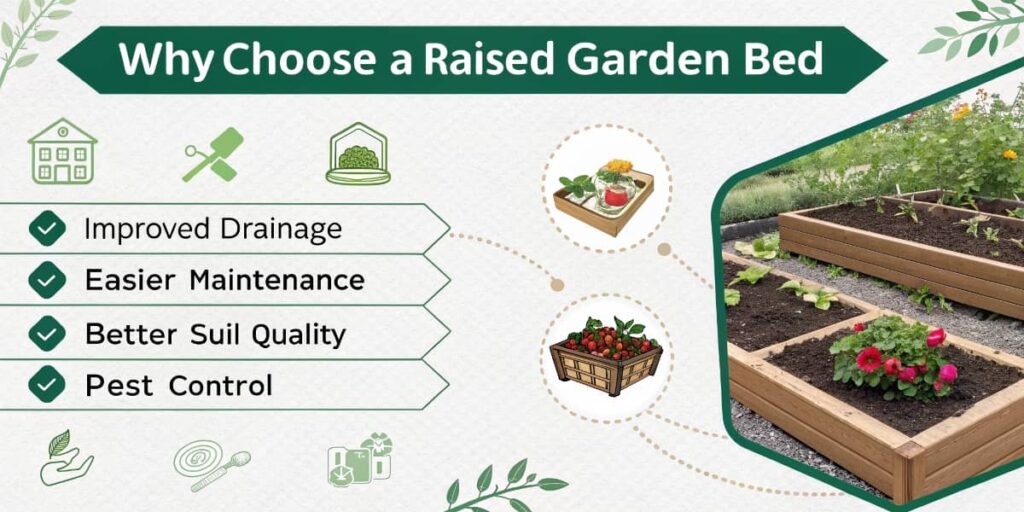
So, why are raised garden beds such a game-changer for home gardeners? Let’s chat about the amazing perks they offer. Think of them as your secret weapon for a healthier, happier garden and a more enjoyable gardening experience.
Superior Soil Control
One of the biggest headaches for gardeners is dealing with bad soil. Maybe your yard has heavy clay that drains poorly, or sandy soil that dries out too fast. With a raised bed, you’re in charge! You get to create the perfect soil mix from scratch. This means you can tailor it exactly to what your plants love. Imagine rich, fluffy soil that’s just right for your vegetables or flowers. This control leads to stronger plants and bigger harvests. It’s like giving your plants a five-star home from day one.
Better Drainage
No one likes soggy roots! Raised beds naturally offer fantastic drainage. Because they’re elevated, excess water can easily escape. This prevents your plants from sitting in water, which can lead to root rot and other problems. Good drainage means healthier roots, and healthy roots mean happy, productive plants. It’s especially helpful if you live in an area with a lot of rain or heavy, slow-draining native soil.
Fewer Weeds & Pests
Ready for less weeding? Raised beds make it much easier. You start with fresh, weed-free soil. Plus, the defined edges of the bed help keep unwanted weeds from creeping in from your lawn. It’s also harder for many common garden pests to reach your plants when they’re elevated. This means less time pulling weeds and battling bugs, and more time enjoying your beautiful garden. It’s a win-win for your back and your plants!
Easier on Your Back
Let’s be honest, gardening can be tough on the body. All that bending, kneeling, and stooping can leave you sore. Raised beds bring the garden up to you! This means less strain on your back and knees. You can comfortably plant, weed, and harvest without feeling like you’ve run a marathon. For many, this ergonomic benefit alone makes raised beds worth it. Gardening should be a joy, not a pain!
Longer Growing Season
Want to get a jump start on spring planting? Raised beds warm up faster in the spring sun. The soil inside the bed heats up more quickly than the ground around it. This allows you to plant earlier in the season. It also means your plants might keep producing later into the fall. So, you get more time to enjoy fresh produce or vibrant blooms. It’s like extending your gardening calendar!
Aesthetic Appeal
Beyond all the practical benefits, raised beds just look good! They add a neat, organized, and intentional look to any yard. You can choose materials and designs that complement your home’s style. Whether you prefer rustic wood, sleek metal, or charming stone, raised beds can be a beautiful focal point. They define your garden space and make it feel like a true outdoor room. It’s gardening that’s both productive and pretty!
Planning Your Raised Garden Bed
Ready to dive in and build your own raised garden bed? Great! Before you grab your tools, a little planning goes a long way. Thinking through a few key things now will save you time and effort later. Let’s make sure your raised bed is set up for success from the very start.
Location, Location, Location
Just like in real estate, location is super important for your garden. Most vegetables and many flowers need plenty of sunshine. Aim for a spot that gets at least 6-8 hours of direct sunlight each day. Watch your yard throughout the day to see where the sun hits. Also, think about water. Is there a hose nearby? You’ll need to water your plants regularly. Finally, consider convenience. Pick a spot that’s easy to access. You’ll be visiting your garden often, so make it a pleasant walk, not a trek.
Size & Height Matters
How big should your raised bed be? It depends on your space and what you want to grow. For width, a good rule of thumb is to make it no wider than 4 feet. This way, you can easily reach the middle from either side without stepping into the bed. Stepping in compacts the soil, and we want that fluffy soil for happy roots! For length, you can go as long as you like. Just remember, longer beds mean more material and more soil.
Now, about height. A bed that’s 6-12 inches deep is good for many plants, especially if your native soil is decent. But if you have really poor soil, or if you want to avoid bending over, go for a deeper bed, maybe 18-24 inches. Taller beds are also great for root vegetables like carrots and potatoes. Think about what feels comfortable for you to work in. Remember, the deeper the bed, the more soil you’ll need to fill it.
Material Selection
Choosing the right material for your raised bed is a big decision. There are lots of options, each with its own look and feel. Wood is a popular choice. Cedar and redwood are naturally rot-resistant and last a long time. Pine is more budget-friendly but might not last as long. Just be sure to avoid pressure-treated wood that contains chemicals, especially if you’re growing food. We don’t want those chemicals leaching into your veggies!
Metal beds, often made from galvanized steel or corten steel, are becoming very popular. They look modern and last for ages. Plastic and composite materials are also options; they’re durable and low-maintenance. You can even get creative with repurposed materials like cinder blocks, wine boxes, or old water troughs. Each material has its own charm and practical considerations. We’ll explore many of these ideas in detail later
Filling Your Raised Garden Bed: The Perfect Soil Recipe
Okay, you’ve picked your perfect raised bed idea. Now, how do you fill it? This is super important! The soil in your raised bed is like the foundation of your garden. Good soil means healthy plants. Let’s talk about making the best soil mix.
First, don’t just use regular garden soil from your yard. It can be too heavy, compacted, and might have weed seeds or diseases. We want to create a special blend that’s light, fluffy, and full of nutrients. This mix will give your plants everything they need to thrive.
Here’s a simple, popular recipe that many experienced gardeners swear by. It’s often called the ‘Mel’s Mix’ or a variation of it. It’s easy to remember and works wonders:
•1/3 high-quality compost: This is the powerhouse! Compost adds tons of nutrients and beneficial microbes. It helps with drainage and holds moisture. You can use different types of compost, like mushroom compost, worm castings, or homemade compost. Mixing them up is even better!
•1/3 peat moss or coco coir: These materials are light and help with water retention. Peat moss is traditional, but coco coir is a more sustainable option. They both create that fluffy texture that roots love. They also help keep the soil from compacting over time.
•1/3 coarse vermiculite or perlite: These are lightweight minerals. They improve drainage and aeration. Vermiculite also holds onto water and nutrients, releasing them slowly. Perlite is great for making the soil extra airy. Both prevent the soil from getting too dense, which is crucial for root growth.
Mix these three ingredients thoroughly. You want a consistent, crumbly texture. It should feel light and airy in your hands. This mix provides excellent drainage, holds moisture well, and gives your plants a nutrient-rich environment.
How to Calculate Soil Needed for Raised Garden Beds
Wondering how much of this amazing soil mix you’ll need? It’s simple math! You need to find the volume of your raised bed. Here’s how:
1.Measure: Get the length, width, and height (or depth) of your raised bed in feet.
2.Multiply: Multiply length x width x height. This gives you the total cubic feet of soil needed.
For example, if your bed is 4 feet long, 4 feet wide, and 1 foot deep: 4 ft x 4 ft x 1 ft = 16 cubic feet of soil. Then, you’ll need about 5.3 cubic feet of each ingredient (16 / 3 = 5.33). Most bags of compost, peat moss, and vermiculite will tell you their volume in cubic feet. It’s always a good idea to buy a little extra, just in case!
Planting & Maintaining Your Raised Garden Bed
Your raised bed is built and filled with amazing soil. What next? It’s time to plant! And then, a little ongoing care will keep your garden thriving. Don’t worry, it’s easier than you think.
Smart Planting Tips
One popular method for planting in raised beds is called square-foot gardening. Instead of planting in long rows, you divide your bed into square-foot sections. Then, you plant a certain number of plants in each square, depending on their size. For example, you might plant 16 carrots in one square foot, or just one tomato plant. This method helps you grow a lot in a small space. It also makes it easy to rotate crops each season.
When you plant, make sure to give each plant enough room to grow. Read the seed packets or plant tags for spacing recommendations. Dig a hole big enough for the plant’s roots. Gently place the plant in the hole, then backfill with your rich soil. Water thoroughly after planting to help settle the soil and reduce transplant shock.
Watering Your Raised Bed
Raised beds drain well, which is great for roots. But it also means they can dry out faster than in-ground gardens. So, consistent watering is key. Check your soil daily, especially during hot, sunny weather. Stick your finger about an inch or two into the soil. If it feels dry, it’s time to water.
Water deeply and slowly. This encourages roots to grow down, making plants more resilient. Drip irrigation or soaker hoses are fantastic for raised beds. They deliver water directly to the roots, saving water and reducing fungal diseases. Overhead watering can lead to more evaporation and wet leaves, which some plants don’t like.
The Magic of Mulch
Mulch is your garden’s best friend. After planting, add a layer of organic mulch around your plants. Think straw, shredded leaves, or wood chips. Mulch does amazing things:
•Keeps moisture in: It acts like a blanket, slowing down evaporation. This means you water less often.
•Controls weeds: It blocks sunlight, stopping weed seeds from sprouting. Less weeding for you!
•Regulates soil temperature: It keeps the soil cooler in summer and warmer in winter.
•Adds nutrients: As organic mulch breaks down, it slowly feeds your soil.
Pest Control in Raised Garden Beds
Raised beds often have fewer pest problems. But if critters do show up, try gentle methods first. Hand-picking larger pests is effective. You can also use insect netting to cover your plants, especially young seedlings. Companion planting, where you grow certain plants together to deter pests, is another natural solution. For example, marigolds can help keep some bad bugs away. Healthy plants are also more resistant to pests, so focus on good soil and proper watering.
Conclusion
There you have it! From classic wooden boxes to creative upcycled solutions and high-tech smart beds, we’ve explored 55 fantastic raised garden bed ideas. We’ve seen how these elevated planting spaces can truly transform your gardening experience. They offer so many benefits: better soil, less weeding, easier access, and a longer growing season. Plus, they add beauty and structure to any outdoor space. Whether you have a sprawling backyard or a tiny balcony, there’s a raised bed idea that’s perfect for you.
Gardening in raised beds is a rewarding journey. It allows you to connect with nature, grow your own food, and create a beautiful oasis right at home. It’s about getting your hands dirty, watching life sprout, and enjoying the fruits (and vegetables!) of your labor. Don’t be afraid to experiment and find what works best for your unique space and style. Every garden is a personal expression, and your raised bed will be a testament to your creativity and passion.
Final Thoughts
Ready to build your dream garden? Don’t wait another season! Pick your favorite idea from this guide and get started today. Even a small raised bed can bring immense joy and fresh produce to your table. Share your raised garden bed creations with us on social media! Use the hashtag #YourBrandNameHere to show off your amazing work. Happy gardening!

